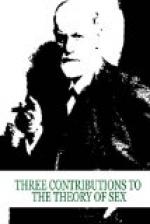PARTIAL IMPULSES AND EROGENOUS ZONES
Keeping in mind what we have learned from the examination of the positive and negative perversions, it becomes quite obvious that they can be referred to a number of “partial impulses,” which are not, however, primary but are subject to further analysis. By an “impulse” we can understand in the first place nothing but the psychic representative of a continually flowing internal somatic source of excitement, in contradistinction to the “stimulus” which is produced by isolated excitements coming from without. The impulse is thus one of the concepts marking the limits between the psychic and the physical. The simplest and most obvious assumption concerning the nature of the impulses would be that in themselves they possess no quality but are only taken into account as a measure of the demand for effort in the psychic life. What distinguishes the impulses from one another and furnishes them with specific attributes is their relation to their somatic sources and to their aims. The source of the impulse is an exciting process in an organ, and the immediate aim of the impulse lies in the elimination of this organic stimulus.
Another preliminary assumption in the theory of the impulse which we cannot relinquish, states that the bodily organs furnish two kinds of excitements which are determined by differences of a chemical nature. One of these forms of excitement we designate as the specifically sexual and the concerned organ as the erogenous zone, while the sexual element emanating from it is the partial impulse.[27]
In the perversions which claim sexual significance for the oral cavity and the anal opening the part played by the erogenous zone is quite obvious. It behaves in every way like a part of the sexual apparatus. In hysteria these parts of the body, as well as the tracts of mucous membrane proceeding from them, become the seat of new sensations and innervating changes in a manner similar to the real genitals when under the excitement of normal sexual processes.
The significance of the erogenous zones in the psychoneuroses, as additional apparatus and substitutes for the genitals, appears to be most prominent in hysteria though that does not signify that it is of lesser validity in the other morbid forms. It is not so recognizable in compulsion neurosis and paranoia because here the symptom formation takes place in regions of the psychic apparatus which lie at a great distance from the central locations for bodily control. The more remarkable thing in the compulsion neurosis is the significance of the impulses which create new sexual aims and appear independently of the erogenous zones. Nevertheless, the eye corresponds to an erogenous zone in the looking and exhibition mania, while the skin takes on the same part in the pain and cruelty components of the sexual impulse. The skin, which in special parts of the body becomes differentiated as sensory organs and modified by the mucous membrane, is the erogenous zone, [Greek: kat] ex ogen.[28]




